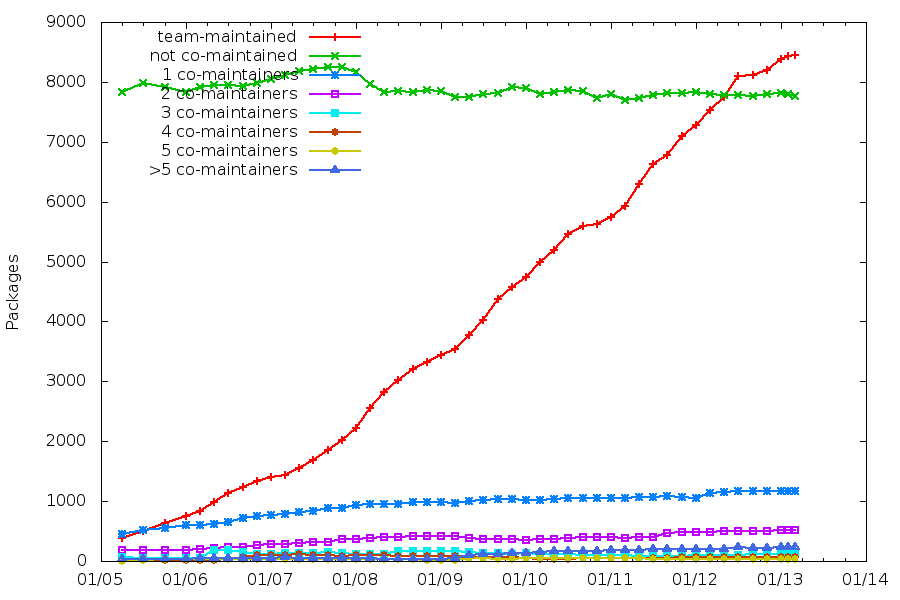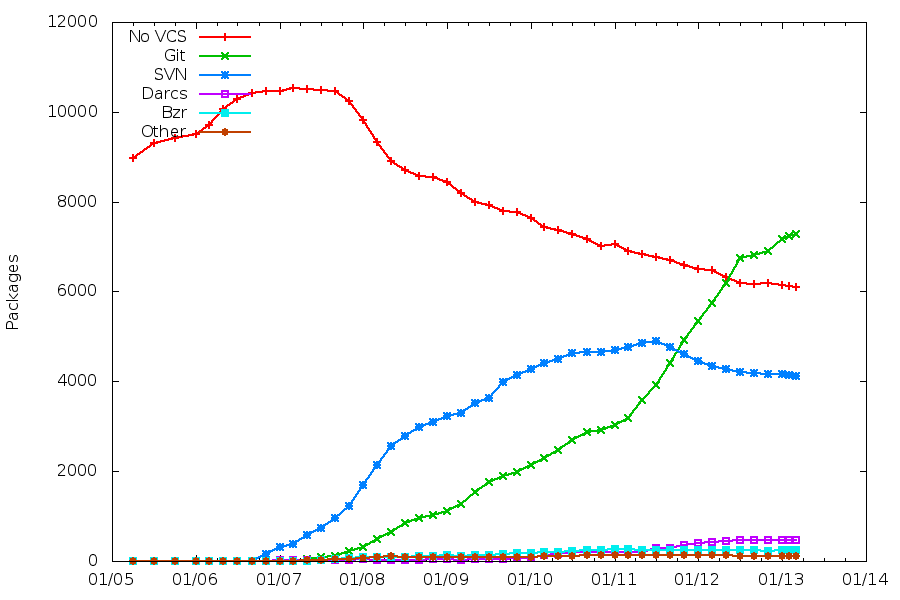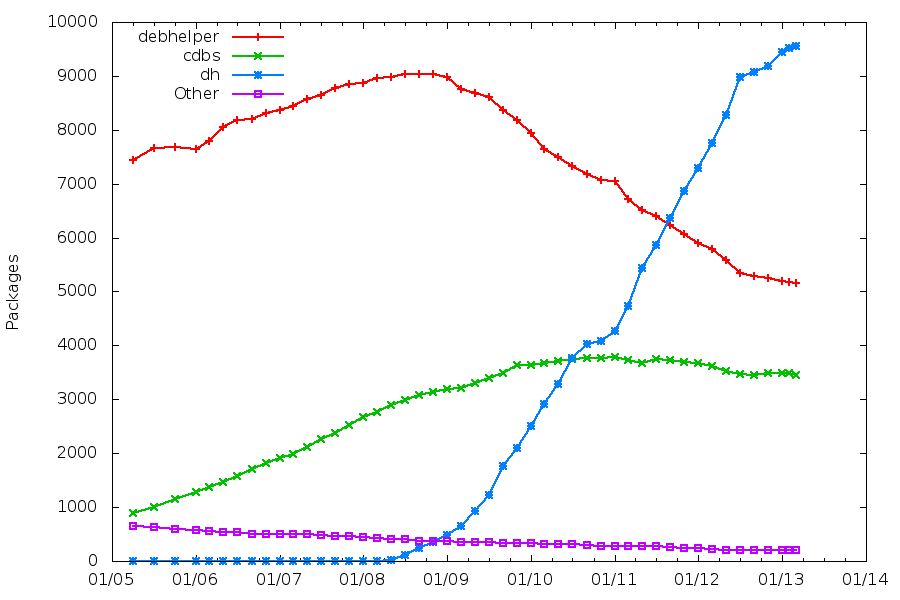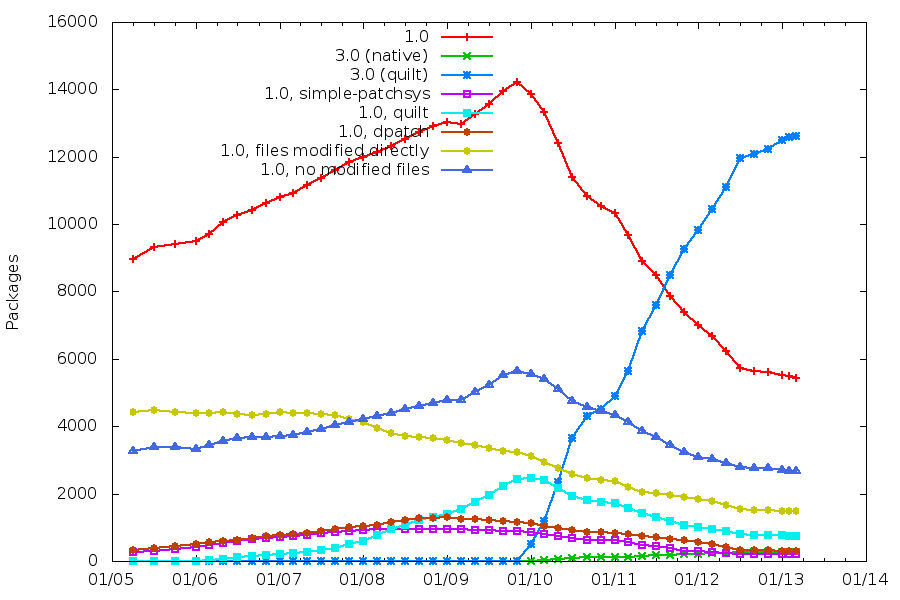(Looking for those graphs online, I realized that I never properly published them, besides that old post)
I’ve been playing with snapshot.d.o, which is a fantastic resource if you want to look at Debian from an historical perspective (well, since 2005 at least).
Team maintenance

We now have more team-maintained packages than packages maintained by someone alone. Interestingly, the “small, ad-hoc group of developers” model does not really take off.
Maintenance using a VCS

A large majority of our packages are maintained in a VCS repository, with Git being the clear winner now.
Possible goal for Jessie: standardize on a Git workflow, since every team tends to design its own?
Packaging helpers
Again, we have a clear winner here, with dh. It’s interesting to note that, while dh was designed as a CDBS killer, it kind-of fails in that role.
Possible goal for Jessie: deprecate at least pure-debhelper packaging?
Patch systems and packaging formats
Again, clear winner with 3.0 (quilt).
The (dirty) scripts that generate those graphs are available in Git (but you need to connect to stabile to execute them, and it’s rather time consuming — hours/days).


hi, interessting to see …
now i do wonder how the “git” part would look if you seperate it by team/single maintainer etc
like
“is there a connection between the used vcs and the numbers of developers”
or
“is there a connection in the used packaging helper regarding if its a single maintainer or a team of people”
maybe also “historical questions” would be interessting to check out, like “since $date it seems like the mariority of new packages prefer to start with dh” (i have seen textual assumptions of this in the past, but no graphs so far)
anyway nice idea, thanks for sharing
The graphs show absolute numbers, but mainly suggest interpretation in a relative sense. For example with the packaging helpers: cdbs seems “constant” while dh is on the rise; however, the total number of packages has increased. As such, a graph showing proportional usage would show that cdbs is in fact deminishing in importance after the arrival of dh.
An interesting figure would be to be able to know how many people actually contributed to the team-maintained packages, because putting packages under a “team” umbrella is relatively easy. Get enough contributors to have that “team” be something really meaningful is a different outreach. (see e.g. the printing team where almost all packages are one-maintainer-only)
I always thought debhelper and dh were the same thing (dh being the short form for debhelper). Can you enlighten me? :)
@Thijs: I agree that the relative number of packages using CDBS has been decreasing, but I think that it’s more interesting to note that it’s due to an increase in the total number of packages, and that the number of packages using CDBS stays stable. Showing proportional usage would lead to information loss in that case.
@Marcus: by “dh”, I mean “debhelper7”, or “the dh command”. “debhelper” is “old-style debhelper packaging, with dh_* commands”
Just a though: for the team-maintained packages, what fraction of that is attributable to the QA Team?
PS Might have tweaked your scripts to check but…
$ ssh stabile.debian.org ls -ld ~lucas/dhistory
drwx—— 4 lucas Debian 8192 Mar 4 13:07 /home/lucas/dhistory
@Barak: permissions fixed. For your question, it is not easy to determine, unfortunately. But I’ll try to address this next time I work on the scripts.
In the graph right above that text, as dh usage increased, CDBS went from steadily increasing to flat and very slightly decreasing. That seems like a pretty clear win for dh. Given that changing from one packaging system to another incurs a lot of churn, it doesn’t surprise me that cdbs usage drops slowly.
@Lucas: I think these graphs are really cool. I’d like to use three of these graphs (with attributing credit) in a presentation concerning Debian Packaging work. I’m sure you wouldn’t mind them being used for this purpose, but I’d like to ask your permission to do that explicitly. Additionally you might mention a license these images are under so that others may do the same. :)
Thanks much.
@ChrisK: I sure won’t mind :)
I’ve added the graphs and the raw data to git, in case you want to regenerate them.
Regarding the license, I don’t really care. Consider them CC-BY.
@Lucas: Sweet. Thanks! :)